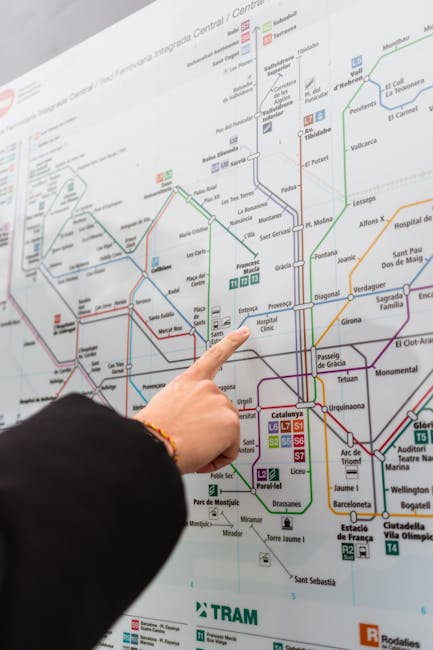Perth Public Transport: Your Ultimate Guide to Trains, Buses & Ferries

Perth Public Transport: Your Ultimate Guide to Trains, Buses & Ferries
Okay, let's talk Perth! Beautiful city, right? But sometimes, figuring out how to get around can feel a little daunting. I totally get it. When I first moved here, I was utterly confused by the whole Transperth system. Trains, buses, ferries…it felt like a foreign language. But don't worry! I've been there, done that, and now I'm here to share all my secrets to navigating Perth's public transport like a pro. Think of me as your friendly Perth transport guru! We'll cover everything from SmartRiders to timetables to those quirky Free Transit Zone buses. By the end of this, you'll be zipping around Perth with confidence.
Understanding the Transperth System

First things first, let's demystify Transperth. That's the name of the game – the umbrella term for all public transport in Perth, covering trains, buses, and ferries. It's all integrated, meaning you can use the same ticket (or SmartRider) across all modes of transport. This makes it super convenient for planning journeys that involve multiple legs.
Think of it like this: Transperth is the orchestra conductor, and the trains, buses, and ferries are the different instruments playing together in harmony to get you where you need to go. The goal is to make getting around Perth as seamless as possible.
The Mighty SmartRider Card: Your Perth Transport Key

If you're going to be in Perth for more than a few days, or even if you're just planning on using public transport a few times, the SmartRider is your best friend. It's a reusable travel card that makes paying for fares a breeze and saves you money compared to buying single tickets. Seriously, get one. You'll thank me later.
Where to Get a SmartRider:
- Transperth Info Centres: You can find these at major train stations like Perth, Elizabeth Quay, and the Airport Central station.
- Retail Outlets: Many newsagents and convenience stores around Perth sell and top-up SmartRiders. Look for the Transperth logo.
- Online: You can also order one online through the Transperth website. Just be aware it might take a few days to arrive.
How to Use a SmartRider:
It's super simple. Just "tag on" when you board a train, bus, or ferry, and "tag off" when you get off. This tells the system how far you've travelled and calculates your fare accordingly. Hold the SmartRider flat against the reader until you see a green tick and hear a beep. Always remember to tag on and tag off! Failing to do so can result in a default fare, which is usually much higher than what you would have paid otherwise, and even a fine. Trust me, it's not worth the risk.
Topping Up Your SmartRider:
Running low on credit? No problem! There are several ways to top up your SmartRider:
- Online: The easiest way, in my opinion. You can link your SmartRider to your account on the Transperth website and top it up whenever you need to. Just remember that it can take up to 24 hours for the credit to appear on your card.
- Transperth Info Centres: Head to one of the Info Centres at major train stations.
- Retail Outlets: Use the same retailers where you purchased your SmartRider.
- Ticket Vending Machines: These are available at most train stations.
- Autoload: Set up Autoload, and your SmartRider will automatically top up when your balance gets low. This is the most hassle-free option.
Different Types of SmartRiders:
It's also worth noting that there are different types of SmartRiders, each with its own benefits:
- Standard SmartRider: The standard option for most adults.
- Concession SmartRider: For students, seniors, and other eligible concession holders. You'll need to apply for this and provide proof of eligibility.
- Seniors SmartRider: For eligible seniors, offering discounted fares and free travel during off-peak hours.
- Child SmartRider: For children aged 5-15.
Navigating the Perth Train Network

Okay, let's delve into the train network. Perth's trains are modern, efficient, and a great way to get around the city and its surrounding suburbs. There are five main lines:
- Joondalup Line: Runs north-south, connecting Joondalup in the north to Mandurah in the south, passing through the Perth CBD.
- Fremantle Line: Runs west from Perth CBD to the coastal city of Fremantle. Perfect for a day trip to the beach!
- Midland Line: Runs east from Perth CBD to Midland, passing through suburbs like Bayswater and Guildford.
- Armadale/Thornlie Line: Runs southeast from Perth CBD, splitting into two branches: one towards Armadale and the other towards Thornlie. Significant upgrades are currently underway on this line, so be aware of potential disruptions.
- Airport Line: A dedicated line that connects Perth CBD to Perth Airport (both Terminals 1/2 and Terminals 3/4).
Reading the Train Timetable:
Train timetables are readily available online and at train stations. They can look a little intimidating at first, but once you understand them, they're pretty straightforward.
Here's what to look for:
- Line Name: Make sure you're looking at the timetable for the correct line.
- Direction: Check whether you're travelling towards or away from Perth CBD.
- Day of the Week: Timetables often differ on weekdays, weekends, and public holidays.
- Departure Times: These are the times the train is scheduled to leave each station. Remember to factor in a few minutes for potential delays.
- Station Names: Look for your starting and destination stations.
Tips for Train Travel:
- Plan Ahead: Use the Transperth JourneyPlanner (more on that later) to plan your route and check the timetable.
- Arrive Early: Give yourself plenty of time to get to the station and find your platform.
- Listen to Announcements: Pay attention to announcements on the platform and on the train, as these will provide updates on any delays or changes to the service.
- Stand Clear of the Doors: Don't block the doors when the train is approaching or departing.
- Offer Your Seat: Be considerate and offer your seat to elderly, pregnant, or disabled passengers.
Exploring Perth by Bus: A Comprehensive Guide

Perth's bus network is extensive, covering virtually every corner of the metropolitan area. It's a vital part of the Transperth system, connecting residential areas, shopping centres, and other important destinations. But, let's be honest, navigating the bus network can feel a bit overwhelming at first. Fear not! I'm here to guide you through it.
Understanding Bus Routes:
Each bus route has a unique number and a destination name. The route number usually indicates the general direction and the area the bus serves. For example, routes in the 300s often serve the northern suburbs, while routes in the 900s are often high-frequency routes connecting major destinations.
Finding Your Bus Stop:
Bus stops are marked with a distinctive Transperth sign, usually displaying the bus route numbers that stop there and a timetable. Some stops also have real-time information displays showing the estimated arrival time of the next bus. These are super handy!
Types of Buses:
Perth has several types of buses, including:
- Standard Buses: These are the most common type of bus and operate on most routes.
- High-Frequency Buses: These buses run more frequently, usually every 10-15 minutes during peak hours. Look for routes with "9" as the first digit (e.g., 950, 960).
- CAT Buses (Central Area Transit): Free buses that operate within the Perth CBD and Fremantle. These are a fantastic way to get around the city centre without spending a cent.
- School Buses: These buses are dedicated to transporting students to and from school and usually operate during school hours.
Using the Bus Timetable:
Similar to train timetables, bus timetables can be found online, at bus stops, and in Transperth Info Centres. Pay attention to the route number, direction, day of the week, and departure times. Remember that bus timetables can be affected by traffic conditions, so it's always a good idea to allow extra time for your journey.
Tips for Bus Travel:
- Check the Route: Make sure you're boarding the correct bus by checking the route number and destination displayed on the front of the bus.
- Signal Your Intention: When you see your bus approaching, signal to the driver by raising your hand. This lets them know you want to board.
- Tag On and Tag Off: Remember to tag on your SmartRider when you board and tag off when you disembark.
- Use the Bell: Press the "Stop" button or pull the cord (if available) a few blocks before your desired stop. This alerts the driver to stop at the next designated bus stop.
- Be Aware of Your Surroundings: Pay attention to your surroundings and keep your belongings safe.
Cruising the Swan River: Ferry Adventures in Perth

For a truly unique Perth experience, hop on a ferry and cruise along the beautiful Swan River. It's not just a mode of transport; it's a scenic adventure! There are two main ferry routes operated by Transperth:
- Perth to South Perth: This short ferry ride connects Elizabeth Quay in Perth CBD to Mends Street Jetty in South Perth. It's a popular option for visiting the Perth Zoo, which is a short walk from the Mends Street Jetty. It also offers stunning views of the Perth skyline.
- Perth to Rottnest Island: While not operated by Transperth directly, numerous ferry services depart from Perth and Fremantle to Rottnest Island. These services need to be booked separately. Rottnest Island is a must-visit for its stunning beaches, turquoise waters, and of course, the adorable quokkas!
Using the Ferry:
The Transperth ferry operates like the other modes of transport. Simply tag on your SmartRider when you board and tag off when you disembark. Check the timetable for departure times, as the ferry service is less frequent than trains and buses.
Tips for Ferry Travel:
- Check the Timetable: Ferries operate on a less frequent schedule than trains and buses, so it's essential to check the timetable in advance.
- Arrive Early: Allow plenty of time to get to the jetty and board the ferry, especially during peak season.
- Enjoy the Views: Relax and enjoy the stunning views of the Swan River and the Perth skyline.
- Be Prepared for the Weather: The Swan River can be exposed to the elements, so dress appropriately for the weather.
The Free Transit Zone (FTZ): Free Rides in the City

One of the best things about Perth's public transport is the Free Transit Zone (FTZ). This zone covers a large area of the Perth CBD and allows you to travel on buses for free within its boundaries. It's a fantastic way to get around the city centre without paying a cent!
Identifying the FTZ:
The FTZ is clearly marked on Transperth maps and at bus stops within the zone. Look for signs that indicate "Free Transit Zone."
CAT Buses:
The CAT buses (Central Area Transit) are specifically designed to operate within the FTZ. These buses are brightly coloured and easy to spot. There are several CAT routes that crisscross the city, making it easy to get to major attractions, shopping centres, and business districts.
Tips for Using the FTZ:
- Know the Boundaries: Familiarize yourself with the boundaries of the FTZ to ensure you're travelling within the free zone.
- Look for the Signs: Pay attention to the signs at bus stops indicating the FTZ.
- Hop On and Hop Off: Take advantage of the free buses to explore the city at your own pace.
Planning Your Journey: The Transperth JourneyPlanner

Now, let's talk about the most important tool in your Perth transport arsenal: the Transperth JourneyPlanner. This online tool and app is a lifesaver for planning your trips, finding the fastest routes, and checking timetables in real-time. Seriously, download the app – it will become your go-to companion!
How to Use the JourneyPlanner:
- Enter Your Starting Point: Type in your current location or the address you're starting from.
- Enter Your Destination: Type in the address or landmark you want to go to.
- Select Your Travel Time: Choose your desired departure or arrival time.
- Click "Plan My Journey": The JourneyPlanner will generate several route options, showing you the different modes of transport you'll need to use, the timetables, and the estimated travel time.
Benefits of Using the JourneyPlanner:
- Real-Time Information: The JourneyPlanner provides real-time information on bus and train arrivals, so you can see if there are any delays or disruptions.
- Route Options: It offers multiple route options, allowing you to choose the one that best suits your needs.
- Step-by-Step Directions: It provides detailed, step-by-step directions, making it easy to follow your route.
- Offline Access: You can save your favourite routes and access them offline, which is useful if you don't have internet access.
Tips and Tricks for a Smooth Ride

Okay, now for some insider tips to make your Perth public transport experience even smoother:
- Download the Transperth App: Seriously, do it. It's the easiest way to access timetables, plan your journey, and check for disruptions.
- Travel During Off-Peak Hours: If possible, avoid travelling during peak hours (7:00-9:00 am and 4:30-6:30 pm) when buses and trains can be crowded.
- Be Patient: Public transport can sometimes be unpredictable. Be prepared for potential delays and be patient with other passengers.
- Use Noise-Cancelling Headphones: Helps to block out the noise and distractions, especially during peak hours.
- Carry a Water Bottle: Staying hydrated is important, especially during Perth's hot summers.
- Be Aware of Your Surroundings: Pay attention to your surroundings and keep your belongings safe.
- Check for Service Disruptions: Before you travel, check the Transperth website or app for any planned service disruptions.
Addressing Common Concerns and FAQs

Let's tackle some common concerns and frequently asked questions about Perth public transport:
Q: What happens if I forget to tag off?
A: You'll be charged a default fare, which is usually the maximum fare for the zone you travelled in. Avoid this by always remembering to tag off!
Q: Can I use cash on buses and trains?
A: No, you can't pay with cash on buses and trains. You need a SmartRider card or a valid paper ticket.
Q: What if I lose my SmartRider card?
A: If you've registered your SmartRider online, you can report it lost or stolen and transfer the remaining balance to a new card. If you haven't registered it, unfortunately, you'll lose the balance.
Q: Are there toilets on trains and buses?
A: No, there are no toilets on trains or buses. However, you can find toilets at most major train stations.
Q: Is Perth public transport accessible for people with disabilities?
A: Yes, Perth public transport is generally accessible for people with disabilities. Most buses and trains have designated seating areas for passengers with disabilities, and many stations have ramps and lifts.
Embrace the Journey!

So there you have it – your ultimate guide to navigating Perth's public transport system. It might seem a little overwhelming at first, but with a little planning and preparation, you'll be zipping around Perth like a local in no time. Embrace the journey, explore the city, and enjoy the ride! Don't be afraid to ask for help if you get lost or confused – Perth locals are generally friendly and happy to assist. And remember, the Transperth JourneyPlanner is your best friend. Happy travels!
Post a Comment